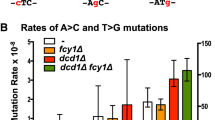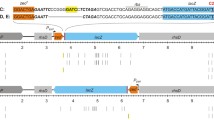Summary
A collection of 164 spontaneous lacI − mutations were recovered from a uracil-DNA glycosylase deficient (Ung−) strain of Escherichia coli and analyzed by DNA sequencing. As predicted by genetic studies, G:C→A:T transitions predominated among base substitution events. However, DNA sequence analysis indicated that these events did not occur at random. Of the 31 G:C→A:T transitions recovered, 24 involved cytosine residues located in the nontranscribed strand of the gene and 15 of the 31 transitions occurred at cytosines located on the 3′ side of 3 or more A:T base pairs. These differentials likely reflect the more single-stranded character of the non-transcribed strand of the gene and of regions rich in A:T base pairs. In addition, mutation at the frameshift hotspot was altered in the Ung− strain, suggesting a role for DNA repair in the formation of structural intermediates that potentiate these events. Also, the analysis of non-hotspot frameshifts, deletions and duplication showed that many involved local DNA sequence. Specifically, several of the frameshift, deletion and duplication mutations occurred near the sequence 5′-CTGG-3′. Thus, DNA sequence analysis of mutational specificity in an Ung− strain has provided evidence that gene expression, DNA repair and DNA context can all potentially influence the classes and frequencies of spontaneous mutation.
Similar content being viewed by others
References
Albertini AM, Hofer M, Calos MP, Miller JH (1982) On the formation of spontaneous deletions: the importance of short sequence homologies in the generation of large deletions. Cell 29:319–328
Bockrath RC, Mosbaugh P (1986) Mutation probe of gene structure in E. coli: Suppressor mutations in the seven tRNA operon. Mol Gen Genet 204:452–456
Coulondre C, Miller JH, Farabaugh PJ, Gilbert W (1978) Molecular basis of base substitution hotspots in Escherichia coli. Nature 274:775–780
Drake JW (1970) The molecular basis of mutation. Holden Day, San Francisco, pp 177–185
Duncan BK, Miller JH (1980) Mutagenic deamination of cytosine residues in DNA. Nature 287:560–561
Farabaugh PJ (1978) Sequence of the lacI gene. Nature 274:765–769
Farabaugh PJ, Schmeissner U, Hofer M, Miller JH (1978) Genetic studies of the lac repressor. VII. On the molecular basis of spontaneous hotspots in the lacI gene of Escherichia coli. J Mol Biol 126:847–863
Fix DF, Glickman BW (1986) Differential enhancement of spontaneous transition mutations in the lacI gene of an Ung− strain of Escherichia coli. Mutat Res 175:41–45
Fix DF, Burns PA, Glickman BW (1987) DNA sequence analysis of spontaneous mutation in a PolA1 strain of Escherichia coli indicates sequence specific effects. Mol Gen Genet, in press
Glickman BW, Ripley LS (1984) Structural intermediates of deletion mutagenesis: a role for palindromic DNA. Proc Natl Acad Sci USA 81:512–516
Glickman BW, Burns PA, Fix DF (1986) Mechanisms of spontaneous mutagenesis: clues from altered mutational specificity in DNA repair defective strains. In: Shankel DM, Hartman PE, Kada T, Hollaender A (eds) Antimutagenesis and anticarcinogenesis, mechanisms. Plenum Press, New York, pp 259–281
Kunkel TA (1984) The mutational specificity of depurination. Proc Natl Acad Sci USA 81:1494–1498
Lieb M, Allen E, Read D (1986) Very short patch mismatch repair in phage lambda: repair sites and length of repair tracts. Genetics 114:1041–1060
Lindahl T (1979) DNA-glycosylases-endonucleases for apurinic/apyrimidinic sites and base excision repair. Prog Nucleic Acid Res Mol Biol 22:135–191
Lindahl T, Nyberg B (1974) Heat induced deamination of cytosine residues in deoxyribonucleic acid. Biochemistry 13:3405–3410
Lu AL, Welsh K, Clark S, Su SS, Modrich P (1984) Repair of DNA base pair mismatches in extracts of Escherichia coli. Cold Spring Harbor Symp Quant Biol 49:589–596
Miller JH (1983) Mutational specificity in bacteria. Annu Rev Genet 17:215–238
Ponticelli AS, Schultz DW, Taylor AF, Smith GR (1985) Chidependent DNA strand cleavage by recBC enzyme. Cell 41:145–151
Richards RG, Sowers LC, Laszlo J, Sedwick WD (1984) The occurrences and consequences of deoxyuridine in DNA. In: G. Weber (ed) Advances in enzyme regulation, Vol 22. Pergamon Press, New York, pp 157–185
Ripley LS (1982) Model for the participation of quasi-palindromic DNA sequences in frameshift mutation. Proc Natl Acad Sci USA 79:4128–4132
Ripley LS, Glickman BW (1982) The unique self-complementarity of palindromic sequences provides DNA structural intermediates for mutation. Cold Spring Harbor Quant Symp Biol 47:851–861
Sargentini NJ, Smith KC (1981) Much of spontaneous mutagenesis in Escherichia coli is due to error-prone DNA repair: implications for spontaneous carcinogenesis. Carcinogenesis 2:863–872
Sargentini NJ, Smith KC (1985) Spontaneous mutagenesis: the roles of DNA repair, replication and recombination. Mutat Res 154:1–27
Schaaper RM, Danforth BN, Glickman BW (1985) Rapid repeated cloning of mutant lac repressor genes. Gene 39:181–189
Schaaper RM, Danforth BN, Glickman BW (1986) Mechanisms of spontaneous mutagenesis: an analysis of the spectrum of spontaneous mutation in the E. coli lacI gene. J Mol Biol 189:273–284
Schmiessner U, Ganem D, Miller JH (1977) Genetic studies of the lac repressor. II. Fine structure deletion map of the lacI gene and its correlation with the physical map. J Mol Biol 109:303–326
Sedwick WD, Brown OE, Glickman BW (1986) Deoxyuridine misincorporation causes site-specific mutational lesions in the lacI gene of Escherichia coli. Mutat Res 162:7–20
Shapiro R, Klein RS (1966) The deamination of cytidine and cytosine by acidic buffer solutions: mutagenic implications. Biochemistry 5:2358–2362
Streisinger G, Okada Y, Emrich J, Newton J, Tsugita A, Terzaghi E, Inouye M (1966) Frameshift mutations and the genetic code. Cold Spring Harbor Symp Quant Biol 33:77–84
Topal MD, Fresco JR (1976) Complementary base pairing and the origin of substitution mutations. Nature 263:285–289
Vogel HJ, Bonner DM (1956) Acetylorithinase of Escherichia coli: partial purification and some properties. J Biol Chem 218:97–106
Von Borstel RC (1969) On the origin of spontaneous mutations. Jpn J Genet 44:102–105
Warner HR, Duncan BK (1978) In vivo synthesis and properties of uracil-containing DNA. In: Molineux I, Kohiyama M (eds) DNA synthesis: Present and future. NATO Advanced Studies Institutes Series A, 17: 267–279
Author information
Authors and Affiliations
Additional information
Communicated by B.J. Kilbey
Rights and permissions
About this article
Cite this article
Fix, D.F., Glickman, B.W. Asymmetric cytosine deamination revealed by spontaneous mutational specificity in an Ung− strain of Escherichia coli . Mol Gen Genet 209, 78–82 (1987). https://doi.org/10.1007/BF00329839
Received:
Issue Date:
DOI: https://doi.org/10.1007/BF00329839




